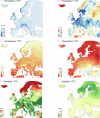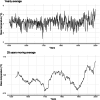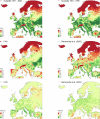A time-varying index for agricultural suitability across Europe from 1500-2000
- PMID: 39824905
- PMCID: PMC11742442
- DOI: 10.1038/s41597-024-04194-z
A time-varying index for agricultural suitability across Europe from 1500-2000
Abstract
Throughout the last centuries, European climate changed substantially, which affected the potential to plant and grow crops. These changes happened not just over time but also had a spatial dimension. Yet, despite large climatic fluctuations, quantitative historical studies typically rely on static measures for agricultural suitability due to the non-availability of time-varying indices. Relying on recent advances in paleoclimatology, we bridge this gap by constructing a spatio-temporal measure for agricultural suitability across Europe for a period of 500 years. Our gridded index has a 0.5° resolution and is available at a yearly level. It relies on a simple surface energy and water balance model, focusing only on so-called exogenous geographic and climatic features. Our index captures not just long-term trends, such as the Little Ice Age, but also short-term climatic shocks. It will empower researchers to explore the interplay between climatic fluctuations and Europe's agricultural landscape, analyze human responses at a local and regional scale, and foster a deeper understanding of the region's historical dynamics.
© 2025. The Author(s).
Conflict of interest statement
Competing interests: The authors declare no competing interests.
Figures










Similar articles
-
The 2023 Latin America report of the Lancet Countdown on health and climate change: the imperative for health-centred climate-resilient development.Lancet Reg Health Am. 2024 Apr 23;33:100746. doi: 10.1016/j.lana.2024.100746. eCollection 2024 May. Lancet Reg Health Am. 2024. PMID: 38800647 Free PMC article. Review.
-
Climate change effects on Chikungunya transmission in Europe: geospatial analysis of vector's climatic suitability and virus' temperature requirements.Int J Health Geogr. 2013 Nov 12;12:51. doi: 10.1186/1476-072X-12-51. Int J Health Geogr. 2013. PMID: 24219507 Free PMC article.
-
Landscape development, forest fires, and wilderness management.Science. 1974 Nov 8;186(4163):487-95. doi: 10.1126/science.186.4163.487. Science. 1974. PMID: 17790369
-
Verifiable soil organic carbon modelling to facilitate regional reporting of cropland carbon change: A test case in the Czech Republic.J Environ Manage. 2020 Nov 15;274:111206. doi: 10.1016/j.jenvman.2020.111206. Epub 2020 Aug 17. J Environ Manage. 2020. PMID: 32818829
-
Climatic suitability of Aedes albopictus in Europe referring to climate change projections: comparison of mechanistic and correlative niche modelling approaches.Euro Surveill. 2014 Feb 13;19(6):20696. doi: 10.2807/1560-7917.es2014.19.6.20696. Euro Surveill. 2014. PMID: 24556349 Review.
References
-
- Ramankutty, N., Foley, J. A., Norman, J. & McSweeney, K. The global distribution of cultivable lands: Current patterns and sensitivity to possible climate change. Global Ecology and Biogeography11, 377–392 (2002).
-
- Cipolla, C. M. The Economic History of World Population (Penguin Books, Baltimore, 1962), 1 edn.
LinkOut - more resources
Full Text Sources
Miscellaneous

